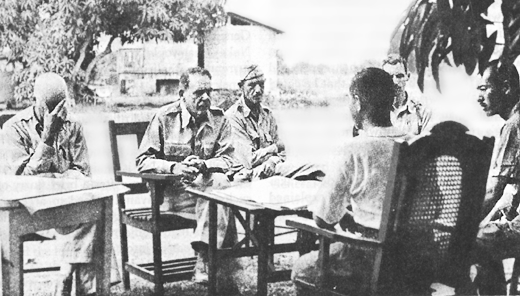|
Criminal Investigation And Detection Group
The Criminal Investigation and Detection Group (CIDG) is the primary investigation arm of the Philippine National Police. History The Criminal Investigation and Detection Group was established as the Criminal Information Service whose origin traces back as early as 1901 shortly after the establishment of the Philippine Constabulary when the Information Section was established as mandated by the Section 2, Article 255 of the Philippine Commission. In 1920 the Information Division was integrated with the United States Army Forces in the Far East and its detectives participated at the Battle of Bataan (1945), Battle of Bataan, many of which also were forced to participate at the Bataan Death March After World War II, the Military Police Command was activated in lieu of the Philippine Constabulary. A Criminal Investigation Branch of the G2 to investigate crimes and maintain peace and order. This division remain operational after the independence of the Philippines from the United St ... [...More Info...] [...Related Items...] OR: [Wikipedia] [Google] [Baidu] |
Philippine National Police
The Philippine National Police ( fil, Pambansang Pulisya ng Pilipinas, acronymed as PNP) is the armed national police force in the Philippines. Its national headquarters is located at Camp Crame in Bagong Lipunan ng Crame, Quezon City. Currently, it has approximately 220,000 personnel to police a population in excess of 100 million. The agency is administered and controlled by the National Police Commission and is part of the Department of the Interior and Local Government (DILG). Local police officers are operationally controlled by municipal mayors. DILG, on the other hand, organizes, trains and equips the PNP for the performance of police functions as a police force that is national in scope and civilian in character. The PNP was formed on January 29, 1991, when the Philippine Constabulary and the Integrated National Police were merged pursuant to Republic Act 6975 of 1990. [...More Info...] [...Related Items...] OR: [Wikipedia] [Google] [Baidu] |
Philippine Constabulary
The Philippine Constabulary (PC; tl, Hukbóng Pamayapà ng Pilipinas, ''HPP''; es, Policía de Filipinas, ''PF'') was a gendarmerie-type police force of the Philippines from 1901 to 1991, and the predecessor to the Philippine National Police. It was created by the American colonial government to replace the Spanish colonial Guardia Civil, happened on the 19th century history of the Philippines. It was the first of the four branches of the Armed Forces of the Philippines. On January 29, 1991, it was merged with the Integrated National Police to form the Philippine National Police. History The Philippine Constabulary (PC) was established on August 18, 1901, under the general supervision of the civil Governor-General of the Philippines, by the authority of Act. No. 175 of the Second Philippine Commission, to maintain peace, law, and order in the various provinces of the Philippine Islands. By the end of 1901, a total of 180 officers had been commissioned.. The consta ... [...More Info...] [...Related Items...] OR: [Wikipedia] [Google] [Baidu] |
United States Army Forces In The Far East
United States Army Forces in the Far East (USAFFE) (Filipino language, Filipino: ''Hukbong Katihan ng Estados Unidos sa Malayong Silangan/HKEUMS''; Spanish language, Spanish: ''Fuerzas del Ejército de los Estados Unidos en el Lejano Oriente'') was a military formation of the United States Army active from 1941 to 1946. The new command's headquarters was created on 26 July 1941, at No. 1, Calle Victoria, Manila, Luzon, the Philippines, with General Douglas MacArthur as commander. The Chief of Staff was Brigadier General Richard K. Sutherland and the Deputy Chief of Staff was Lieutenant Colonel Richard J. Marshall. The core of this command (including MacArthur, Marshall, and Sutherland) was drawn from the Office of the Military Advisor to the Commonwealth Government of the Philippines. Creation of this command led to the subordination of the headquarters of the Philippine Department of the U.S. Army, as a service command, since planning and tactical control were now under USAFFE c ... [...More Info...] [...Related Items...] OR: [Wikipedia] [Google] [Baidu] |
Battle Of Bataan (1945)
The Battle for the Recapture of Bataan (Filipino: ''Labanan para sa Bataan'') from 31 January to 21 February 1945, by US forces and Allied Filipino guerrillas from the Japanese, part of the campaign for the liberation of the Philippines, was waged to secure the western shore of Manila Bay to enable the use of its harbor and open new supply lines for American troops engaged in the crucial battle for the liberation of Manila. The Bataan peninsula's recapture also avenged the surrender of the defunct United States Armed Forces in the Far East (USAFFE) to invading Japanese forces on 9 April 1942. Background The rapid advance of US forces heading towards Manila had strained the capability of their supply lines at Lingayen Gulf, which had so ably supplemented their push south on the capital, almost to the breaking point. While the capture of Manila was significant for both military and psychological reasons, the seizure of Manila Bay was crucial from a logistical point of view. I ... [...More Info...] [...Related Items...] OR: [Wikipedia] [Google] [Baidu] |
Bataan Death March
The Bataan Death March (Filipino: ''Martsa ng Kamatayan sa Bataan''; Spanish: ''Marcha de la muerte de Bataán'' ; Kapampangan: ''Martsa ning Kematayan quing Bataan''; Japanese: バターン死の行進, Hepburn: ''Batān Shi no Kōshin'') was the forcible transfer by the Imperial Japanese Army of between 60,000 and 80,000 American and Filipino prisoners of war from Saysain Point, Bagac, Bataan and Mariveles to Camp O'Donnell, Capas, Tarlac, via San Fernando, Pampanga, the prisoners being forced to march despite many dying on the journey. The transfer began on April 9, 1942, after the three-month Battle of Bataan in the Philippines during World War II. The total distance marched from Mariveles to San Fernando and from the Capas Train Station to Camp O'Donnell is variously reported by differing sources as between . Sources also report widely differing prisoner of war casualties prior to reaching Camp O'Donnell: from 5,000 to 18,000 Filipino deaths and 500 to 650 American death ... [...More Info...] [...Related Items...] OR: [Wikipedia] [Google] [Baidu] |
Armed Forces Of The Philippines
The Armed Forces of the Philippines (AFP) ( fil, Sandatahang Lakas ng Pilipinas) are the military forces of the Philippines. It consists of three main service branches; the Army, the Air Force, and the Navy (including the Marine Corps). The President of the Philippines is the Commander-in-Chief of the AFP and forms military policy with the Department of National Defense, an executive department acting as the principal organ by which military policy is carried out, while the Chief of Staff of the Armed Forces of the Philippines serves as the overall commander and the highest-ranking officer in the AFP. Founded under the National Defense Act of 1935, while tracing its roots to the Philippine Revolutionary Army, the AFP has played an integral part in the country's history. The AFP has also been involved in various conflicts, such as combatting rebellion against the Communist Party of the Philippines (CPP) and it's attached organizations, the New People's Army (NPA) and the Nati ... [...More Info...] [...Related Items...] OR: [Wikipedia] [Google] [Baidu] |

.png)
